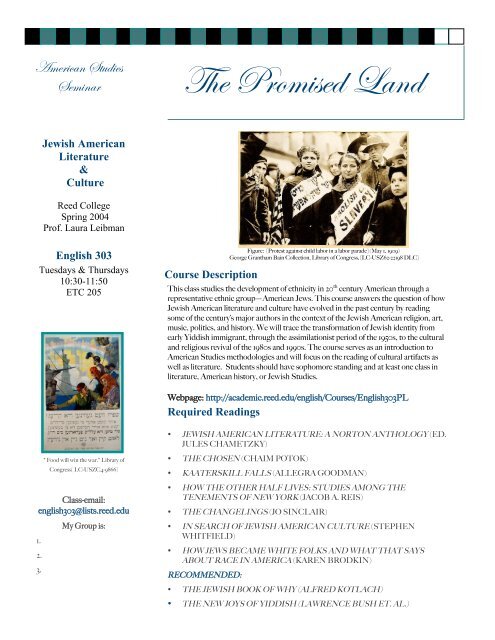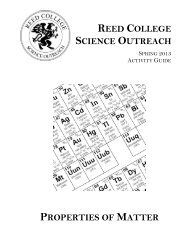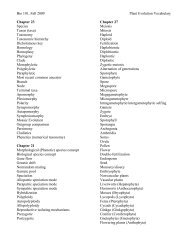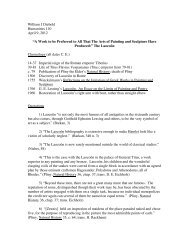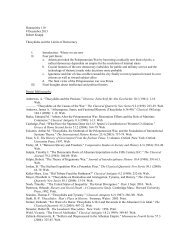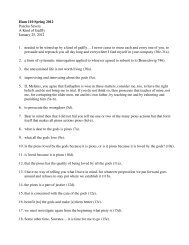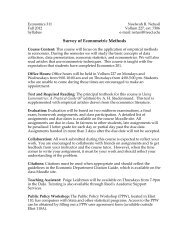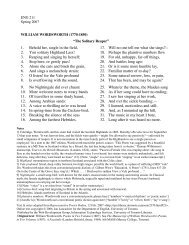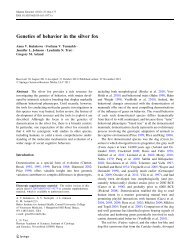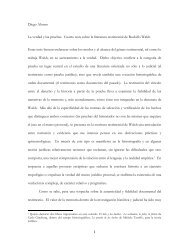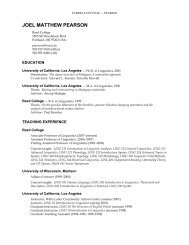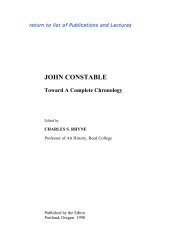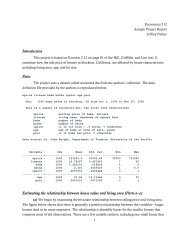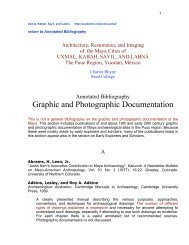The Promised Land - Reed College
The Promised Land - Reed College
The Promised Land - Reed College
Create successful ePaper yourself
Turn your PDF publications into a flip-book with our unique Google optimized e-Paper software.
American Studies<br />
Seminar<br />
Class-email:<br />
english303@lists.reed.edu<br />
1.<br />
2.<br />
3.<br />
Jewish American<br />
Literature<br />
&<br />
Culture<br />
<strong>Reed</strong> <strong>College</strong><br />
Spring 2004<br />
Prof. Laura Leibman<br />
English 303<br />
Tuesdays & Thursdays<br />
10:30-11:50<br />
ETC 205<br />
" Food will win the war." Library of<br />
Congress[ LC-USZC4-9866]<br />
My Group is:<br />
<strong>The</strong> <strong>Promised</strong> <strong>Land</strong><br />
Course Description<br />
Figure: [Protest against child labor in a labor parade] (May 1, 1909)<br />
George Grantham Bain Collection, Library of Congress, [LC-USZ62-22198 DLC]<br />
This class studies the development of ethnicity in 20 th century American through a<br />
representative ethnic group—American Jews. This course answers the question of how<br />
Jewish American literature and culture have evolved in the past century by reading<br />
some of the century’s major authors in the context of the Jewish American religion, art,<br />
music, politics, and history. We will trace the transformation of Jewish identity from<br />
early Yiddish immigrant, through the assimilationist period of the 1950s, to the cultural<br />
and religious revival of the 1980s and 1990s. <strong>The</strong> course serves as an introduction to<br />
American Studies methodologies and will focus on the reading of cultural artifacts as<br />
well as literature. Students should have sophomore standing and at least one class in<br />
literature, American history, or Jewish Studies.<br />
Webpage: http://academic.reed.edu/english/Courses/English303PL<br />
Required Readings<br />
• JEWISH AMERICAN LITERATURE: A NORTON ANTHOLOGY (ED.<br />
JULES CHAMETZKY)<br />
• THE CHOSEN (CHAIM POTOK)<br />
• KAATERSKILL FALLS (ALLEGRA GOODMAN)<br />
• HOW THE OTHER HALF LIVES: STUDIES AMONG THE<br />
TENEMENTS OF NEW YORK (JACOB A. REIS)<br />
• THE CHANGELINGS (JO SINCLAIR)<br />
• IN SEARCH OF JEWISH AMERICAN CULTURE (STEPHEN<br />
WHITFIELD)<br />
• HOW JEWS BECAME WHITE FOLKS AND WHAT THAT SAYS<br />
ABOUT RACE IN AMERICA (KAREN BRODKIN)<br />
RECOMMENDED:<br />
• THE JEWISH BOOK OF WHY (ALFRED KOTLACH)<br />
• THE NEW JOYS OF YIDDISH (LAWRENCE BUSH ET. AL.)
Page 2 of 8<br />
Schedule of Readings<br />
Weeks 1-3: INTRODUCTION & METHODS<br />
Problem 1: WHAT IS AN (AMERICAN) JEW?<br />
What are the defining characteristics of American Jews? What makes them different from other Jews?<br />
What is distinctive about their literature and lives?<br />
T 1.27 INTRODUCTION TO THE PROBLEM: What is a Jew? Readings Artifacts. Creating<br />
Interview Questions. (Resource: Getting Started: What is Oral History?<br />
http://www.oralhistory.org.uk/advice/)<br />
R 1.29 REQUIRED WEB SEMINAR (Regular Room)<br />
Bring with you: one paragraph of text and URL of one website.<br />
Readings: Overviews for the following sections in Jewish American Literature: A Norton Anthology:<br />
<strong>The</strong> Great Tide, 1881-1924 (109-121); From Margin to Mainstream in Difficult Times, 1924-1945 (327-333);<br />
Achievement and Ambivalence, 1945-1973 (575-585); Wandering and Return: Since 1973 (979-985)<br />
T 2.3 WHAT IS JEWISH AMERICAN LITERATURE?<br />
Wirth-Nesher, "Defining the Undefinable: What is Jewish Literature" (What is Jewish Literature? 3-12)<br />
Stephen J. Whitfield, "Definitions," In Search of American Jewish Culture (1-31)<br />
R 2.5<br />
Testing the Norton's Narrative: Family history presentations. Refining the Question and Addressing<br />
Commonalities. Please bring an-electronic version of your history to class with you as we will have a short<br />
workshop to help you create a webpage out of the history.<br />
T 2.10 Case Study: Chaim Potok, <strong>The</strong> Chosen<br />
T 2.10 Optional Movie Night: <strong>The</strong> Producers (7-9 pm MRC)<br />
R 2.12 <strong>The</strong> Chosen, cont.<br />
T 2.17 <strong>The</strong> Chosen, cont.<br />
Family Histories must be posted online by Monday 2.16.04.<br />
Weeks 4-7: MELTING POT: THE GREAT TIDE (1881-1924)<br />
R 2.19 <strong>The</strong> Problem: You have been hired to be a consultant for a a museum exhibit that combines<br />
literature and material culture about the Great Tide period, focusing on immigrants from one particular<br />
country (e.g. Russia, Poland, Greece, etc.) You wil need to supply answers to the following questions:<br />
What qualities distinguish the literature and culture of American Jewry from this era? When does an<br />
immigrant become an "America"?<br />
<strong>The</strong> Problem Staged:<br />
Jacob Reis, How the Other Half Lives (1-16, 82-102)<br />
Moyshe-Leyb Halpern, "In the Golden <strong>Land</strong>" (248)<br />
Anzia Yezierska, "Children of Loneliness" (234-244)<br />
T 2.24 REQUIRED LIBRARY SEMINAR & WORKSHOP (Meet in Library 17)
Page 3 of 8<br />
Groups will meet to discuss their strategies for this section of the syllabus. <strong>The</strong> librarians will review<br />
researching strategies and tools and provide time to assist each group in finding their resources. By the end<br />
of the library session each group must post the readings they will be using for the next week and a half.<br />
T 2.24 Optional Movie Night: Hester Street (7-9 pm MRC)<br />
R 2.26 PRIMARY TEXT: GROUP 1<br />
Readings: To be chosen by Group 1 from Jewish American Literature: A Norton Anthology<br />
Due date: all members of Group 1 post assignment 2a 24 hours before class:<br />
T 3.2 CRITICAL ARTICLES: GROUP 2<br />
Readings: Article to be chosen by Group 2.<br />
Due date: all members of Group 2 post assignment 2b 24 hours before class<br />
R 3.4 CULTURAL ARTIFACTS: GROUP 3<br />
Readings: Cultural Artifacts posted on-line by Group 3 and articles & primary texts from previous two days<br />
Due date: all members of Group 3 post assignment 2c 24 hours before class<br />
Sunday 3.7 PURIM!<br />
Weeks 7-10: ASSIMILATIONIST WOES: ACHIEVEMENT AND AMBIVALENCE<br />
(1945-1973)<br />
T 3.19 <strong>The</strong> Problem: World War II has often been seen as a watershed moment in American and world<br />
culture and is used as the starting point for "postmodern" literature. For American Jews the holocaust<br />
would have deeper ramifications and would mark a paradoxical moment in time: at the same time that<br />
Germans were bent upon eliminating Jews, Americans were slowly come to accept Jews as "white folks."<br />
For many American Jews, this newfound status meant an obligation to help elimate other forms of racism in<br />
America; indeed, many young liberal Jews were involved in the civil rights movement. For others, the<br />
newfound status was precarious at best and to be well guarded, lest prejudice and oppression return. Your<br />
job is to formulate a response to the anti-Semetic poem, "Hey, Jew boy..." from the perspective of two of the<br />
characters in Sinclair's the Changlings or from the view of two other literary characters from this era What<br />
did it mean for Jews at this time to be "white" and Jewish? How does Sinclair's vision of being white and<br />
Jewish differ from that of other writers and thinkers of this era?<br />
<strong>The</strong> Problem Staged:<br />
"Hey, Jew boy..." (Strangers & Neighbors, 657; Handout)<br />
Karen Brodkin, "How Did the Jews Become White Folks?" How Jews Became White Folks and What<br />
That Says About Race in America (25-52)<br />
Jo Sinclair, Chapters 1-7 THE CHANGLINGS (1-127)<br />
R 3.11 <strong>The</strong> Changlings, cont.<br />
"Blacks and Jews: An Interview with Julius Lester" (Strangers & Neighbors, 669-680); "Hey, Jew boy..."<br />
(Strangers & Neighbors, 657)<br />
3.13-3.21 SPRING BREAK!<br />
T 3.23 MANDATORY WEB SEMINAR<br />
Get more Web Page Making Skills, Meet with Group to Map Out Upcoming Readings. By the end of the<br />
session each group must post the readings they will be using for the next week and a half.<br />
T 3.23 Optional Movie Night: Blacks and Jews: A Documentary(7-9 pm MRC)<br />
Online transcript of film: http://www.newsreel.org/transcripts/blacksan.htm
R 3.25 PRIMARY TEXTS: GROUP 2<br />
Readings: To be chosen by Group 2 from Jewish American Literature: A Norton Anthology<br />
Due date: all members of Group 2 post assignment 2a 24 hours before class<br />
T 3.30 CRITICAL ARTICLES: GROUP 3<br />
Readings: Article to be chosen by Group 3<br />
Due date: all members of Group 3 post assignment 2b 24 hours before class<br />
R 4.1 CULTURAL ARTIFACTS: GROUP 1<br />
Readings: Cultural Artifacts posted on-line by Group 1<br />
Due date: all members of Group 1 post assignment 2c 24 hours before class<br />
Weeks 10-12: TESHUVA: WANDERING AND RETURN (Since 1973)<br />
Page 4 of 8<br />
T 4.6 NO CLASS--PASSOVER<br />
Optional Reading: Allegra Goodman, "<strong>The</strong> Four Questions" (Norton); Joel Gereboff, “One Nation, with<br />
Liberty and Haggadahs for All,” Key Texts in American Jewish Culture, ed. Jack Kugelmass (275-92).<br />
W 4.7 Optional Movie Night: <strong>The</strong> Jew in the Lotus (7-9 pm MRC)<br />
R 4.8 <strong>The</strong> Problem:<br />
Poet Rodger Kamentz recounts how in 1989 the Dalai Lama compared the plight of the Tibetans to that of<br />
the Jews and "turned for the first time to the Jewish people for help. 'Tell me your secret,' he said, 'the secret<br />
of the Jewish spiritual survival'" (<strong>The</strong> Jew in the Lotus 2). Kamentz has his own answer to this, but other<br />
writers have suggested that the "strength of American Judaism is that American Jews are constantly testing,<br />
trying, experimenting, and innovating." (Max Dimont,<strong>The</strong> Jews in America 1978: 188). Conversely,<br />
secular writer Robert Eisenberg suggests that strictness of observance is the future of American Judaism.<br />
Eisenberg proposes, "Imagine: It is the year 2075, and the only Jews left in the United States, aside from a<br />
few old-timers, are Hasidism and other Orthodox Jews. Impossible you say? Actually, it's quite likely" (1).<br />
Your job is to a formulate a response to the Dalai Lama's query, with an American bent. What is the secret<br />
of Jewish spiritual and literary survival in the 1970s to the present?<br />
<strong>The</strong> Problem Staged:<br />
Robert Eisenberg, "A Map of the Hasidism: An Introduction," Boychiks in the Hood, (1-8)<br />
Rodger Kamentz, "Introduction," <strong>The</strong> Jew in the Lotus (1-4)<br />
Allegra Goodman, Kaaterksill Falls (Parts 1 & 2, pp. 3-133)<br />
T 4.13 NO CLASS--PASSOVER<br />
R 4.15 Kaaterksill Falls, cont.<br />
Rabbi Eliyahu Klugman, "Chapter 17: <strong>The</strong> Principle," Rabbi Samson Raphael Hirsch (200-208)<br />
T 4.20 LIBRARY/WEB DAY (Meet in Library 17)<br />
(No readings). By the end of the library session each group must post the readings they will be using for<br />
the next week and a half.<br />
R 4.22 PRIMARY TEXT(S): GROUP 3<br />
Readings: To be chosen by Group 3 from Jewish American Literature: A Norton Anthology<br />
Due date: all members of Group 3 post assignment 2a 24 hours before class<br />
T 4.27 CRITICAL ARTICLES: GROUP 1
Readings: Article to be chosen by Group 1<br />
Due date: all members of Group 1 post assignment 2b 24 hours before class<br />
T 4.27 Optional Movie Night: Annie Hall or Fires in the Mirror (7-9 pm MRC)<br />
R .29 CULTURAL ARTIFACTS: GROUP 2<br />
Readings: Cultural Artifacts posted on-line by Group 2<br />
Due date: all members of Group 2 post assignment 2c 24 hours before class<br />
FINAL PROJECTS<br />
5.10 Final Projects need to be posted on your WebPages.<br />
Assignments<br />
E-PORTFOLIO<br />
Page 5 of 8<br />
All of your work for this semester will be posted online in an electronic portfolio. You will be responsible<br />
for creating and maintaining your personal pages as well as a group webpage. On Wednesday Jan. 29th we<br />
will meet in our usual room to learn how to use the technology you will need to complete the course<br />
assignments, and to create your homepage. If you already know how to make a WebPages, we still need you<br />
in class to help others, to share tips on what makes a good page, and to begin to make your portfolio and<br />
Group page.<br />
Three items need to be posted on your WebPage Portfolio throughout the semester: (1) your family history<br />
(2) your portion of the three assignments from the "Melting Pot, "Assimilation Woes," and "Teshuva"<br />
sections of the syllabus (one each of a textual annotation, a bibliography entry, and an annotated cultural<br />
artifact); and (3) your final project. <strong>The</strong>re are no other papers or exams in this course.<br />
Please note: web projects must be posted by the dates listed below. You may, however, continue to update<br />
them throughout the semester.<br />
1. FAMILY HISTORY<br />
Write a family history outlining when your family came to the United States and what they have done since<br />
the arrived. Your goal is to test the standard narrative given for Jewish American History in the 20th<br />
century as provided by Jewish American Literature: A Norton Anthology (JALNA) using at least three of<br />
the four eras:<br />
A. <strong>The</strong> Great Tide, 1881-1924.<br />
B. From Margin to Mainstream in Difficult Times, 1924-1945.<br />
C. Achievement and Ambivalence, 1945-1973.<br />
D. Wandering and Return: Since 1973.<br />
If your family was not Jewish, explain what ethnicity (ethnicities) they are and compare their trajectory to<br />
the one given in JALNA. For many ethnic groups, the trajectory will look similar, but will vary depending<br />
on when that group arrived in the United States, how they arrived, and the extent that group was perceived<br />
to be "white."<br />
For this project please use at least three of the following sources:<br />
1. Interview with a Family Member of a different generation than your own 1<br />
1 Interview at least one member of your family from another generation to ask them about their views on what it means<br />
to be an American Jew (or an American if they are not Jewish). If your family is not Jewish, you may want to ask them
Page 6 of 8<br />
2. Documents from Family (Birth Certificates, Marriage Certificates, Immigration Papers, etc)<br />
3. Family Photos<br />
4. Family Tree<br />
For each of the three eras you cover, you should answer what it meant to be a(n America)Jew" (or an<br />
American of a different ethnic group) for your family.<br />
Expected Length: one paragraph to page per era. Three eras required. Date Due: Eelectronic (non web)<br />
Draft 2.5.04; Web Version Posted 2.16.04<br />
2. "MELTING POT," "ASSIMILATION WOES," "TESHUVA"<br />
ASSIGNMENTS<br />
A. PRIMARY TEXTS: ANNOTATION<br />
Overview: Compose a hypertext to explain one of the primary documents and to connect it to the other<br />
readings, theory, discussions, and classmates presentations. Your audience is other members of the class as<br />
well as friends who are interested in the class but were unable to take it this semester. (I.e. do not assume<br />
prior knowledge when you build the page.)<br />
Detailed Instructions: First, your group will need to agree on which primary text you would like to use (feel<br />
free to consult with me). Once you have determined the primary text, each person should choose a<br />
paragraph, illustration, or stanza to annotate as a hypertext. You may break this text down into sections,<br />
illustrate it with relevant visual images, or connect it to whatever other materials you deem useful. One goal<br />
of this hypertext is to provide other members of the class with information they would need to know in<br />
order to understand the primary text. You may want to include links to relevant allusions, other parts of the<br />
text, other primary texts we have studied, critical articles, prior postings by your classmates, or ideas<br />
covered in class discussion. Since your goal is to unpack these connections, you will need to explain your<br />
links so that outsiders will know why they are relevant and important. Your links should include two<br />
connections to other postings by your classmates (either from this section of the course, or from earlier<br />
ones). You may also include a brief introduction to the passage if you find that helpful. Your annotation<br />
should be posted on your WebPages and should be linked to on your group's WebPages at least 24 hours<br />
before you are schedule to lead discussion.<br />
Deadlines: This assignment is to be posted the night before your group is scheduled to lead discussion on<br />
the primary text for the "Melting Pot," "Assimilation Woes," or "Teshuva" sections of the syllabus. Note<br />
that this means that you will only do one of these annotations per semester. <strong>The</strong> purpose of this assignment<br />
is to provide the rest of the class with a close reading of an excerpt of the primary text.<br />
Evaluation: I will be asking both your groupmates and yourself to evaluate the pages based on (1) how well<br />
your page accomplish the assignment and (2) how well your page works as a webpage. You should feel free<br />
to make changes to your page and update it as you learn new tricks or think of new connections.<br />
B. CRITICAL ARTICLES: ANNOTATED BIBLIOGRAPHY ENTRIES<br />
<strong>The</strong> night before your group is scheduled to lead discussion on the critical articles for the "Melting Pot,"<br />
"Assimilation Woes," or "Teshuva" sections of the syllabus, you will be responsible for posting an annotated<br />
bibliography entry on a relevant critical article. See the "sample annotated bibliography" in the class reader<br />
for examples. At the top of the abstract should be the title of the article and the citation in MLA format.<br />
This abstract should be emailed to the class and posted on your WebPages at least 24 hours prior to the day<br />
to relate any experiences they have had with Jews or what they think makes an (American) Jew a "Jew." You may want<br />
to compare your interviewees ideas with your own views.
Page 7 of 8<br />
you have signed up for on the syllabus. Your abstract should be posted on your WebPages and should be<br />
linked to on your group's WebPages at least 24 hours before you are schedule to lead discussion.<br />
C. CULTURAL ARTIFACTS<br />
This assignment is to be posted the night before your group is scheduled to lead discussion on the cultural<br />
artifact for the "Melting Pot," "Assimilation Woes," OR "Teshuva" sections of the syllabus. Each member<br />
of the group should identify one cultural artifact on the web that relates to the discussion from the<br />
preceding days. Provide a brief (one paragraph) analysis of that artifact that links it to (1) the questions<br />
raised on the first day of the unit; (2) the primary texts; and (3) the critical articles. Your may find Stephen<br />
Whitefield's In Search of Jewish American Culture to be a useful starting point for analyzing your object.<br />
Your artifact and analysis should be posted on your WebPages and should be linked to on your group's<br />
WebPages at least 24 hours before you are schedule to lead discussion.<br />
3. FINAL PROJECT: CRITICAL EDITION<br />
<strong>The</strong> final assignment for this course is to write an on-line critical edition for one of the primary texts for this<br />
semester. Your edition should include<br />
1. A critical introduction that positions the work in the context of the historical era, Jewish American<br />
literature, and critical readings on the period.<br />
2. A sample page from the text that is annotated with links that help the reader understand the text as a<br />
whole and its relationship to the ideas covered in this course.<br />
3. A Cultural Contexts section that includes at least 5 related cultural artifacts and a brief explanation of the<br />
relevance of each to the primary text<br />
4. A bibliography both of works used in preparing your project and of works that the reader might turn to if<br />
(s)he wanted to learn more about the subjects you have discussed.<br />
5. A connection to at least one of the Family Histories (either yours or your classmates').<br />
Your final project is intended to build off of the work you and your classmates have been doing all semester.<br />
You should feel free to use some of the materials you have written in your earlier assignments and you<br />
should link your page to the work of at least three other students in the course (e.g. prior assignments,<br />
course discussion, annotations).<br />
Due date: All final projects must be posted by Monday of Finals week (5.10.04).
Page 8 of 8<br />
<strong>Reed</strong> <strong>College</strong> Jewish Film Series Spring 2004<br />
Tuesday 2.10 <strong>The</strong> Producers (7-9 pm MRC) (1968)<br />
Starring: Zero Mostel, Gene Wilder. Director: Mel Brooks. Mel Brooks's directorial debut remains both a career high<br />
point and a classic show business farce. Mostel is Max Bialystock, a gone-to-seed Broadway producer who spends his<br />
days wheedling checks from his "investors," elderly women for whom Bialystock is only too willing to provide company.<br />
When wide-eyed auditor Leo Bloom (Wilder) comes to check the books, he unwittingly inspires the wild-eyed Max to<br />
hatch a sure-fire plan: sell 25,000% of his next show, produce a deliberate flop, and then abscond with the proceeds.<br />
Unfortunately for the producers (but fortunately for us), their candidate for failure is the musical Springtime for Hitler,<br />
a Brooksian conceit that envisions what Nazi Propaganda minister Joseph Goebbels might have accomplished with a<br />
little help from choreographer Busby Berkeley. Runtime: 90 Minutes.<br />
Tuesday 2.24 Hester Street (7-9 pm MRC) (1975)<br />
Starring: Steven Keats, Carol Kane Director: Joan Micklin Silver. Hester Street depicts the assimilation of Jewish<br />
immigrants in America in the late 1800s. Steven Keats is Jake, a self-made Yankee who shaves off his beard and side<br />
curls in favor of an updated look. An émigré from Russia, Jake's been living in New York's Lower East Side for five<br />
years, taking up with a new woman and earning enough money to support his dance hall ways. To his dismay, his wife,<br />
Gitl (played charmingly by Carol Kane), and son, Yossele, join him from the Old World. Jake is embarrassed by his<br />
wife, who retains her religious ways, wearing the wigs and scarves that tradition dictates. In turn, Gitl is distraught over<br />
the changes in Jake, who insists on calling their son Joey and trying to modernize them both. Runtime: 92 Minutes<br />
Tuesday 3.23 Blacks and Jews: A Documentary (7-9 pm MRC) (1997)<br />
Producers: Alan Snitow, Deborah Kaufman and Bari Scott, Directors: Alan Snitow, Deborah Kaufman. <strong>The</strong> faultline<br />
between Blacks and Jews is one of the most visible symbols of America's racial divide. This film, made collaboratively<br />
by Jewish and Black filmmakers, goes behind the headlines and the rhetoric to try to heal the misunderstanding and<br />
mistrust. This documentary covers key events such as “blockbusting” in 1960s Chicago, a controversial Oakland<br />
screening of Schindler’s List, the Crown Heights Riots in New York. Mayor Willie Brown, Jr. (San Francisco)<br />
remarked, "Blacks & Jews will help make it possible for African Americans to understand Jewish sensitivities - and help<br />
make Jewish Americans more attentive to the challenges facing the black community. Members of both communities -<br />
indeed, ALL communities in America - need to see and discuss this important film." Runtime: 85 minutes.<br />
Wednesday 4.7 <strong>The</strong> Jew in the Lotus (7-9 pm MRC) (1998)<br />
In 1990, eight Jewish delegates traveled to Dharamsala, India, to meet with the XIV Dalai Lama of Tibet and share<br />
“the secret of Jewish spiritual survival in exile.” When writer Rodger Kamenetz was invited to go along to chronicle the<br />
event, unexpectedly, his whole life changed. Kamenetz begins an intense personal journey that leads him back to his<br />
Jewish roots. As he discovers, sometimes you have to go far away to find your way home. Inspired by Kamenetz's best<br />
selling book, <strong>The</strong> Jew in the Lotus, award winning filmmaker Laurel Chiten's documentary fills in what the book left<br />
out. Focusing on the author's particular odyssey of suffering and the role of spirituality as a universal theme, this film<br />
touches audiences on deep emotional levels. It does not put itself forth as a definitive look at Judaism or Buddhism but<br />
is a complete portrait of a man who is still in the process of formation. Runtime: 59 minutes.<br />
Tuesday 4.27 Annie Hall OR Fires in the Mirror (7-9 pm MRC) (Selection TBA)<br />
Annie Hall (1977). Starring: Woody Allen, Diane Keaton. Director: Woody Allen<br />
This is Allen at his best. (For those who may only have seen Allen’s recent films, it will come as a surprise that his early<br />
films are incredibly funny.) <strong>The</strong> film traces the romantic adventures of neurotic New York comedian Alvy Singer<br />
(Woody Allen) and his equally neurotic “shiksha” girlfriend Annie Hall (Diane Keaton). <strong>The</strong> film covers the course of<br />
their relationship from their first meeting, and serves as an interesting historical document about love in the 1970s.<br />
Runtime: 94 Minutes<br />
Fires in the Mirror (1991) is Anna Deavere Smith's mesmerizing one-woman performance piece in which she plays over<br />
30 characters--young and old, black and white, male and female--all embroiled in the racial conflict that erupted in<br />
Crown Heights, Brooklyn, in the summer of 1991. Drawn from interviews from residents and national figures, this<br />
collection of true voices laced with humor, pathos and anger depict the compelling and challenging American debate on<br />
race. Runtime: 87 minutes.


